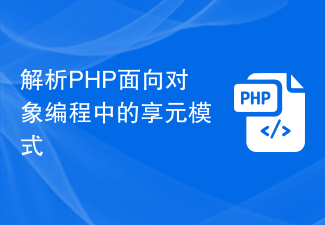What is builder pattern?
A design pattern that separates the construction of a complex object from its representation so that the same construction process can create different representations.
Design scenario:
There is a user's UserInfo class. To create this class, you need to create the user's name, age, hobbies and other information to obtain the user's specific information. result.
Create a UserBuilder user builder class. This class encapsulates the complex creation of UserInfo's name, age, hobbies and other operations, simplifying the creation process of user classes.
This is a User class
class UserInfo
{
protected $_userName;
protected $_userAge;
protected $_userHobby;
public function setUserName($userName)
{
$this->_userName = $userName;
}
public function setUserAge($userAge)
{
$this->_userAge = $userAge;
}
public function setUserHobby($userHobby)
{
$this->_userHobby = $userHobby;
}
public function getPeopleInfo()
{
echo "<br>这个人的名字是:" . $this->_userName . "<br>年龄为:" . $this->_userAge . "<br>爱好:" . $this->_userHobby;
}
}At this time we need to obtain a user's information. The process is as follows:
$modelUser = new UserInfo(); $modelUser->setUserName('松涛'); $modelUser->setUserAge('23'); $modelUser->setUserHobby('推理小说'); $modelUser->getPeopleInfo();
The result obtained is:
The person's name is :Songtao
Age: 23
Hobbies: Mystery novels
Create a user builder class at this time
class UserBuilder
{
protected $_obj;
public function __construct()
{
$this->_obj = new UserInfo();
}
public function builderPeople($userInfo)
{
$this->_obj->setUserName($userInfo['userName']);
$this->_obj->setUserAge($userInfo['userAge']);
$this->_obj->setUserHobby($userInfo['userHobby']);
}
public function getBuliderPeopleInfo()
{
$this->_obj->getPeopleInfo();
}
}This will be complicated The creation process is encapsulated in the builderPeople method. The next step is to create the object:
$userArr = array( 'userName' => '松涛',
'userAge' => '23',
'userHobby' => '推理小说');
$modelUserBuilder = new UserBuilder();
$modelUserBuilder->builderPeople($userArr);
$modelUserBuilder->getBuliderPeopleInfo();The output result is:
The person’s name is: Songtao
The age is: 23
Hobby: Mystery novels
Advantages:
The builder pattern can well separate the implementation of an object from the related "business" logic, so that the event logic can be used without changing the event logic. , making it very easy to add (or change) implementations.
Disadvantages:
Modification of the builder interface will lead to modifications of all execution classes.
The builder pattern should be used in the following situations:
1. The product object that needs to be generated has a complex internal structure.
2. The properties of the product objects that need to be generated depend on each other, and the builder pattern can force the generation order.
3. During the object creation process, some other objects in the system will be used, which are not easy to obtain during the creation of product objects.
Based on the above examples, we can get the effects of the builder pattern:
1. The use of the builder pattern allows the internal appearance of the product to change independently. Using the builder pattern eliminates the need for the client to know the details of the product's internal makeup.
2. Each Builder is relatively independent and has nothing to do with other Builders (independent control logic).
3. The final product built by the model is easier to control.
The difference between builder mode and factory mode:
We can see that builder mode and factory mode are very similar. Overall On the other hand, the builder mode only has one more "director" role than the factory mode. In the class diagram of the builder pattern, if the director class is regarded as the client that is ultimately called, then the rest of the diagram can be regarded as a simple factory pattern.
Compared with the factory pattern, the builder pattern is generally used to create more complex objects. Because the object creation process is more complicated, the object creation process is separated to form a new class - Director kind. In other words, the factory pattern encapsulates the entire object creation process in the factory class, and the factory class provides the final product to the client; in the builder pattern, the builder class generally only provides the construction of each component in the product class. The specific construction process is handed over to the director class. The director class is responsible for configuring each component into a product according to specific rules, and then delivering the assembled product to the client.
The above is the detailed content of Advanced object-oriented design patterns: builder pattern. For more information, please follow other related articles on the PHP Chinese website!
 如何使用Go语言实现面向对象的事件驱动编程Jul 20, 2023 pm 10:36 PM
如何使用Go语言实现面向对象的事件驱动编程Jul 20, 2023 pm 10:36 PM如何使用Go语言实现面向对象的事件驱动编程引言:面向对象的编程范式被广泛应用于软件开发中,而事件驱动编程是一种常见的编程模式,它通过事件的触发和处理来实现程序的流程控制。本文将介绍如何使用Go语言实现面向对象的事件驱动编程,并提供代码示例。一、事件驱动编程的概念事件驱动编程是一种基于事件和消息的编程模式,它将程序的流程控制转移到事件的触发和处理上。在事件驱动
 解析PHP面向对象编程中的享元模式Aug 14, 2023 pm 05:25 PM
解析PHP面向对象编程中的享元模式Aug 14, 2023 pm 05:25 PM解析PHP面向对象编程中的享元模式在面向对象编程中,设计模式是一种常用的软件设计方法,它可以提高代码的可读性、可维护性和可扩展性。享元模式(Flyweightpattern)是设计模式中的一种,它通过共享对象来降低内存的开销。本文将探讨如何在PHP中使用享元模式来提高程序性能。什么是享元模式?享元模式是一种结构型设计模式,它的目的是在不同对象之间共享相同的
 go语言是面向对象的吗Mar 15, 2021 am 11:51 AM
go语言是面向对象的吗Mar 15, 2021 am 11:51 AMgo语言既不是面向对象,也不是面向过程,因为Golang并没有明显的倾向,而是更倾向于让编程者去考虑该怎么去用它,也许它的特色就是灵活,编程者可以用它实现面向对象,但它本身不支持面向对象的语义。
 python是面向对象还是面向过程Jan 05, 2023 pm 04:54 PM
python是面向对象还是面向过程Jan 05, 2023 pm 04:54 PMpython是面向对象的。Python语言在设计之初,就定位为一门面向对象的编程语言,“Python中一切皆对象”就是对Pytho 这门编程语言的完美诠释。类和对象是Python的重要特征,相比其它面向对象语言,Python很容易就可以创建出一个类和对象;同时,Python也支持面向对象的三大特征:封装、继承和多态。
 PHP面向对象编程入门指南Jun 11, 2023 am 09:45 AM
PHP面向对象编程入门指南Jun 11, 2023 am 09:45 AMPHP作为一种广泛使用的编程语言,已成为构建动态网站和网络应用程序的首选语言之一。其中,面向对象编程(OOP)的概念和技术越来越受到开发者的欢迎和推崇。本篇文章将为读者提供PHP面向对象编程的入门指南,介绍OOP的基本概念,语法和应用。什么是面向对象编程(OOP)?面向对象编程(Object-OrientedProgramming,简称OOP),是一种编程
 如何使用Go语言实现面向对象的数据库访问Jul 25, 2023 pm 01:22 PM
如何使用Go语言实现面向对象的数据库访问Jul 25, 2023 pm 01:22 PM如何使用Go语言实现面向对象的数据库访问引言:随着互联网的发展,大量的数据需要被存储和访问,数据库成为了现代应用开发中的重要组成部分。而作为一门现代化、高效性能的编程语言,Go语言很适合用来处理数据库操作。而本文将重点讨论如何使用Go语言实现面向对象的数据库访问。一、数据库访问的基本概念在开始讨论如何使用Go语言实现面向对象的数据库访问之前,我们先来了解一下
 面向对象是啥意思Jul 17, 2023 pm 02:03 PM
面向对象是啥意思Jul 17, 2023 pm 02:03 PM面向对象是软件开发方法,一种编程范式。是一种将面向对象的思想应用于软件开发过程并指导开发活动的系统方法。这是一种基于“对象”概念的方法论。对象是由数据和允许的操作组成的包,它与目标实体有直接的对应关系。对象类定义了一组具有类似属性的对象。面向对象是基于对象的概念,以对象为中心,以类和继承为构建机制,认识、理解和描绘客观世界,设计和构建相应的软件系统。
 如何通过PHP面向对象简单工厂模式实现对象的多态性Sep 05, 2023 am 08:43 AM
如何通过PHP面向对象简单工厂模式实现对象的多态性Sep 05, 2023 am 08:43 AM如何通过PHP面向对象简单工厂模式实现对象的多态性简单工厂模式是一种常见的设计模式,它可以通过一个共同的工厂类来创建不同类的对象,并且隐藏了对象的创建过程。PHP面向对象简单工厂模式可以帮助我们实现对象的多态性。简单工厂模式包含三个基本角色:工厂类、抽象类和具体类。首先我们来定义一个抽象类Animal,它包含一个抽象方法say():abstractclas


Hot AI Tools

Undresser.AI Undress
AI-powered app for creating realistic nude photos

AI Clothes Remover
Online AI tool for removing clothes from photos.

Undress AI Tool
Undress images for free

Clothoff.io
AI clothes remover

AI Hentai Generator
Generate AI Hentai for free.

Hot Article

Hot Tools

MantisBT
Mantis is an easy-to-deploy web-based defect tracking tool designed to aid in product defect tracking. It requires PHP, MySQL and a web server. Check out our demo and hosting services.

mPDF
mPDF is a PHP library that can generate PDF files from UTF-8 encoded HTML. The original author, Ian Back, wrote mPDF to output PDF files "on the fly" from his website and handle different languages. It is slower than original scripts like HTML2FPDF and produces larger files when using Unicode fonts, but supports CSS styles etc. and has a lot of enhancements. Supports almost all languages, including RTL (Arabic and Hebrew) and CJK (Chinese, Japanese and Korean). Supports nested block-level elements (such as P, DIV),

Zend Studio 13.0.1
Powerful PHP integrated development environment

Dreamweaver CS6
Visual web development tools

Safe Exam Browser
Safe Exam Browser is a secure browser environment for taking online exams securely. This software turns any computer into a secure workstation. It controls access to any utility and prevents students from using unauthorized resources.






